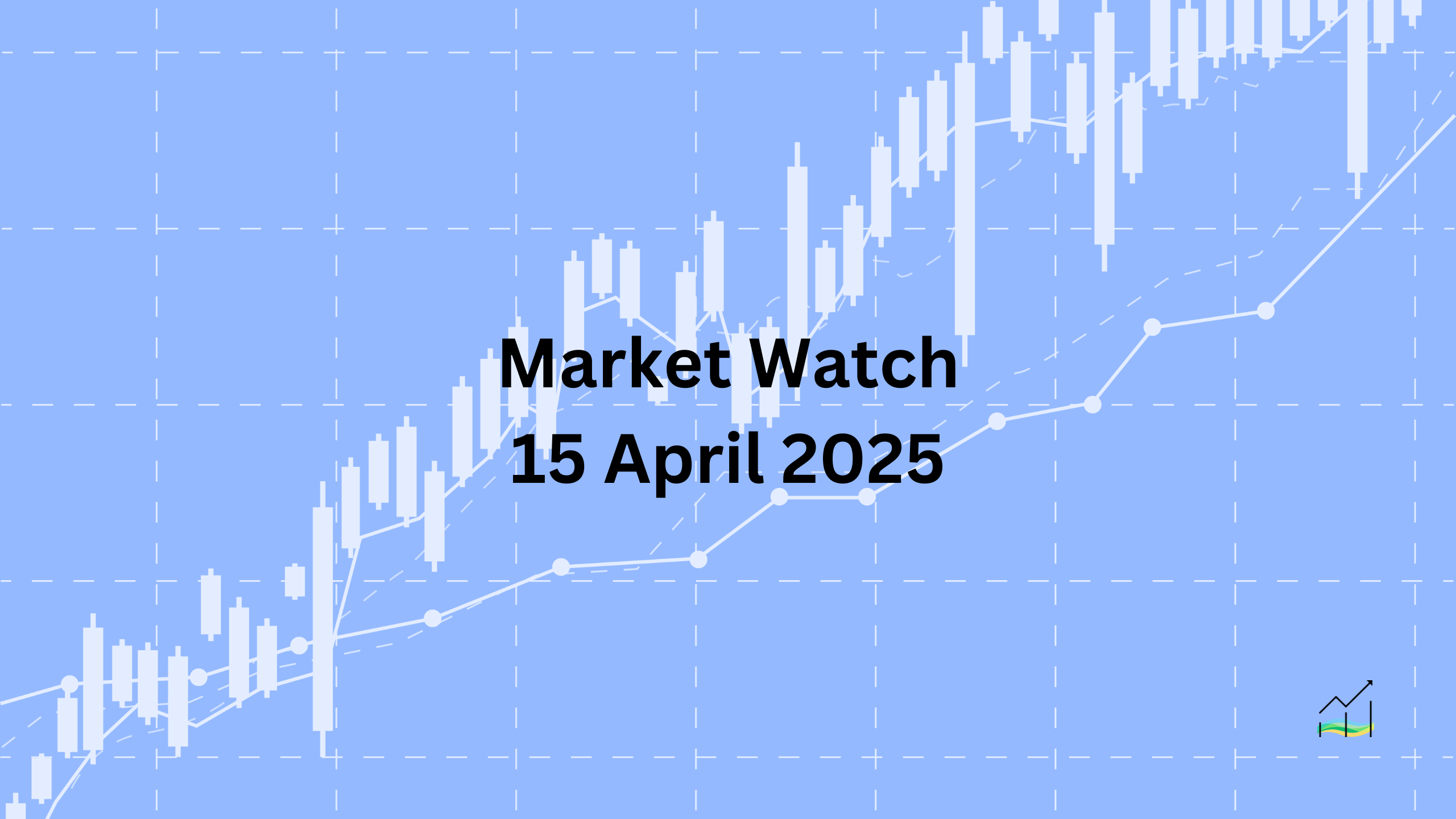15/04/2025 Market Watch

Tariff Postponements Stabilize Markets
Key Takeaways:
- US delays reciprocal tariffs and hints at postponing auto tariffs, calming investor sentiment.
- Sterling, Australian dollar, and potentially Canadian dollar show notable strength.
- Equities recover, with Asia and Europe extending gains; US futures also stronger.
- US Treasury yields remain stable, gold holds near record highs, oil prices steady.
Investor sentiment has steadied following announcements from the US government postponing reciprocal tariffs, clarifying exemptions on popular consumer goods (particularly from China), and signaling a potential delay in the implementation of auto tariffs scheduled for May 3. This easing of trade-related uncertainty has allowed markets to consolidate, boosting equities and providing stability across currency markets.
Sterling and the Australian dollar have notably strengthened, extending recent gains, with the Canadian dollar poised to follow suit. Emerging market currencies present a mixed picture, lacking a clear regional trend.
Asia-Pacific markets continue to build on yesterday’s positive momentum, while Europe's Stoxx 600 rose over 1%, potentially marking its first consecutive daily gains since mid-March. US index futures reflect optimism ahead of the trading session. European 10-year bond yields have risen slightly, except the UK Gilt, which is outperforming peers today. Meanwhile, the benchmark 10-year US Treasury yield remains nearly unchanged at around 4.38%.
In commodities, gold prices remain elevated, consolidating near their recent record of $3246 per ounce. Oil (May WTI) shows stability, trading within a tight range around $61.25–$62.00.
United States of America
Overview
The Dollar Index remains under pressure, consolidating quietly within a narrow range after declining for the fifth consecutive session. Trade policy uncertainty continues to weigh on sentiment, especially with unresolved tariff threats on sectors like semiconductors and pharmaceuticals. However, recent announcements suggest the US administration is sensitive to market reactions, potentially limiting further aggressive moves. Upcoming economic data is unlikely to significantly shift current market dynamics.
Economic Drivers
- Continued uncertainty around US sectoral tariffs, especially on semiconductors, pharmaceuticals, lumber, and dairy.
- Signals from President Trump indicating possible delay of auto tariffs, highlighting the administration’s concern about negative market impacts.
- Potential congressional intervention in US trade policy, exercising constitutional powers to regulate commerce.
- Inflation pressures remain subdued; import price data suggests limited external inflationary pressures.
Data and Events
- April 15, 2025: NY Fed Manufacturing Survey (typically limited market impact)
- April 15, 2025: US Import/Export Prices (expected YoY import price slowdown from 2.0% to 1.4%, monthly unchanged)
Price Action
- Dollar Index consolidating in narrow range (~99.50–100.00), signaling potential continuation lower.
- Technical patterns suggest market positioning for another leg downward after recent declines.
Key Points:
- Dollar weaker, consolidating quietly ahead of potential further declines.
- Tariff policy uncertainty persists, but aggressive moves are tempered by market concerns.
- Inflation data expected to confirm low import-driven price pressures.
- Congressional role may increase as checks on US trade policy emerge.
Australia
Overview
The Australian dollar continues to rally strongly, rising approximately 7.25% over the past four sessions. This notable recovery from recent multi-year lows is underpinned by positive technical momentum and easing concerns around aggressive central bank action. Australia's inclusion on the US Treasury's shortlist for trade negotiations further supports investor optimism.
Economic Drivers
- Reduced expectations for aggressive interest rate cuts by the Reserve Bank of Australia (RBA).
- Market speculation may still be overstating the probability of a larger-than-expected rate cut.
- Australia’s inclusion on the US Treasury Secretary’s shortlist for trade talks signals improving economic sentiment.
Data and Events
- April 30, 2025: Australia's Q1 CPI data release—anticipated to reflect easing inflation pressures, potentially guiding the RBA’s next policy move.
Price Action
- AUD/USD recovered strongly from five-year lows (~$0.5915), reaching near $0.6380.
- Critical resistance around $0.6400 level—historically significant barrier since December.
- Favorable momentum indicators suggest potential for continued upward movement.
Key Points:
- AUD has risen sharply amid improving sentiment and technical momentum.
- Market overestimating potential severity of future RBA rate cuts.
- CPI data on April 30 crucial for confirming future policy direction.
- Technical resistance at $0.6400 remains key.
Canada
Overview
The Canadian dollar remains resilient, poised to strengthen further as the US dollar struggles to regain traction, nearing its fifth consecutive session of declines. Attention is turning towards Canada’s inflation data, anticipated to show moderate upward pressure, reinforcing expectations that the Bank of Canada (BoC) will maintain its cautious stance, especially given the upcoming election.
Economic Drivers
- Canadian CPI expected to show moderate inflation pressure, with core inflation slightly higher, supporting BoC's stance to hold rates steady.
- Market expectations for rate cuts in Canada have eased, reflecting improving economic sentiment.
- Upcoming Canadian elections adding caution to BoC policy decisions.
Data and Events
- April 15, 2025: March Housing Starts and Existing Home Sales
- April 15, 2025: March CPI release—headline inflation expected to rise 0.7% MoM, YoY ticking slightly up to 2.7%; core inflation expected at 3.0% YoY.
- April 16, 2025: Bank of Canada interest rate decision—expected to hold rates steady.
Price Action
- USD/CAD remains under pressure, facing resistance near the 1.3910 level.
- Yesterday's low around 1.3830 marks a key support; likely to be tested again.
- Technical signals favor continued Canadian dollar strength if support breaks.
Key Points:
- CAD strengthening amid weakening USD and positive inflation outlook.
- CPI data crucial, expected to reinforce BoC’s cautious approach.
- Technical indicators support potential further CAD gains.
- BoC likely on hold, awaiting clearer signals post-election.
China
Overview
The offshore yuan weakened slightly against the dollar yesterday, breaking its recent trend of strength, though it remains largely in consolidation. Despite recent US tariff escalations, China's response appears measured, signaling restraint rather than pursuing aggressive currency depreciation. Beijing continues shifting its economic narrative towards self-reliance amid escalating trade tensions, highlighted by its recent decision to halt Boeing aircraft deliveries.
Economic Drivers
- US tariff uncertainty persists, particularly around semiconductor sectors, though recent exemptions on consumer electronics offer temporary relief.
- China reducing reliance on US trade, with exports to the US now accounting for around 15% of total exports, down from 20% in 2017.
- Shift in China's economic strategy toward greater domestic resilience and self-sufficiency ("self-reliance and hard work").
- Beijing halts Boeing aircraft deliveries, escalating the economic impact of trade tensions.
Data and Events
- April 16, 2025: China’s Q1 2025 GDP and March economic data—anticipated to align closely with official target (~5% annual growth).
Price Action
- USD/CNH slightly firmer but remains below key resistance at approximately CNH7.3365.
- Onshore yuan largely stable year-to-date against USD; notable depreciation against other major trade partners.
- Consolidation likely to continue without clear momentum until trade policy clarifies further.
Key Points:
- Yuan stability reflects Beijing’s cautious approach amid US tariff pressures.
- Economic strategy now centered on domestic self-reliance and minimizing US exposure.
- Upcoming GDP data expected to confirm steady, official growth trajectory (~5%).
- Boeing delivery halt signals ongoing trade-related tensions.
Europe
Overview
The euro’s rally has paused after a strong two-day climb, showing signs of consolidation while holding above key technical support. While industrial production data surprised to the upside, the sharp deterioration in investor sentiment reflected in the ZEW survey, coupled with global trade tensions, has capped broader enthusiasm. Despite mixed signals, the euro remains technically constructive unless support is breached.
Economic Drivers
- Eurozone industrial production rose by 1.1% in February, exceeding forecasts and marking the strongest increase since February 2023.
- Investor sentiment weakened sharply, with the ZEW expectations index plunging from 51.6 to -14.0, reflecting growing concern over external pressures such as US tariffs.
- The ZEW current assessment rose for the fourth month in a row, signaling tentative improvement in underlying economic conditions.
Data and Events
- April 16, 2025: ZEW Economic Sentiment Survey – Expectations declined sharply to -14.0, lowest since July 2023; current assessment improved to -81.2.
Price Action
- EUR/USD consolidating after recent 3.7% rally; trading within an inside range.
- Support seen at $1.1250; a break could trigger a move toward $1.1180.
- As long as $1.1250 holds, structure remains technically constructive.
Key Points:
- Euro stalls after sharp rally but remains above key support.
- Industrial production beats expectations, offering a positive signal.
- ZEW expectations plunge, dragging on investor sentiment.
- Price action holds inside recent ranges, with technical support in focus.
Japan
Overview
The Japanese yen is holding in a narrow range, with the dollar consolidating below recent highs as US yields retreat. Weak domestic economic data, including a sharp decline in core machine orders, reflects growing signs of a slowdown in Japan. While a short-term rebound is expected in upcoming data, the broader trend points to softening momentum. Markets are paring back expectations for further policy tightening by the Bank of Japan.
Economic Drivers
- Japan’s economy is slowing sharply; Q1 2025 GDP expected to expand just 0.3% annualized, following an already weak 2024.
- Core machine orders fell by 3.5%; a rebound is anticipated but does not change the underlying weakness.
- Market pricing for BoJ rate hikes has eased significantly—only ~15 bp of tightening expected now, compared to 30 bp at March-end.
Data and Events
- April 16, 2025: Core Machinery Orders (expected rebound following sharp March decline)
- May 2025 (TBD): Q1 2025 GDP estimate—median forecast at 0.3% annualized
Price Action
- USD/JPY range-bound between ~JPY142.70 and JPY143.60; still inside Friday’s broader range.
- A deeper pullback in US 10-year yields (which fell 11 bps to below 4.38%) could pressure USD/JPY lower.
- Break below JPY142 may expose support zone at JPY140.00–JPY140.50.
Key Points:
- Japanese economy showing signs of significant deceleration.
- Yen remains range-bound but could strengthen if US yields continue falling.
- Market is dialing back BoJ tightening expectations.
- Technical focus on JPY142 level—break could accelerate yen gains.
United Kingdom
Overview
Sterling continues to push higher, reaching new recent highs despite overstretched momentum in the short term. While recent strength is partly attributed to short covering ahead of the jobs report, fundamental expectations around monetary policy remain intact. Markets remain confident that the Bank of England will begin easing at its May 8 meeting, especially given subdued economic growth and easing inflation pressures.
Economic Drivers
- Bank of England is widely expected (90%+ probability) to cut rates at the May 8 meeting.
- Economic growth stagnated in H2 2024, reinforcing the case for policy support.
- Average earnings growth remains elevated, slowing only modestly, indicating gradual easing ahead.
- Unemployment steady at 4.4%, the highest since Q3 2021, but not signaling deterioration.
Data and Events
- April 16, 2025: UK Employment Report – likely not a game changer for policy outlook.
- April 17, 2025: UK Inflation Report – expected to reinforce expectations of a rate cut.
Price Action
- GBP/USD reached a new high near $1.3240, above the April 3 peak.
- Trading above the upper Bollinger Band (~$1.3200), indicating stretched short-term momentum.
- Intraday indicators suggest the pair may pause or consolidate, especially ahead of upcoming data.
Key Points:
- Sterling rallies despite firm expectations of a May rate cut by the BoE.
- Labor market remains stable; earnings slightly softening but still elevated.
- Inflation data likely to support gradual easing narrative.
- Technicals stretched but trend remains constructive unless key levels break.
© 2025 SKONE Enterprise (003319453-V). All rights reserved.
The content on this site is for informational purposes only and does not constitute financial advice.


